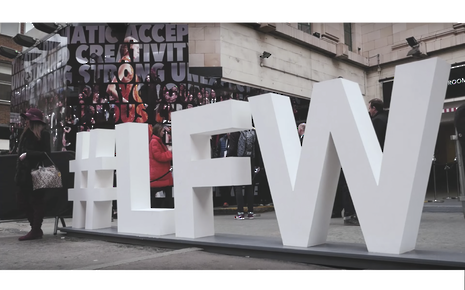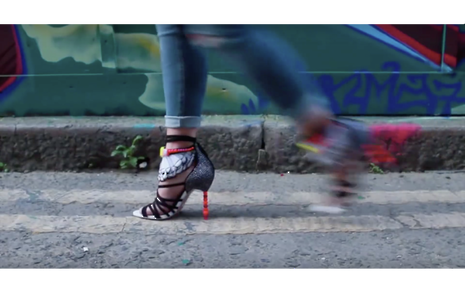Preview: London Fashion Week
In the first of a series of articles, Robyn Schaffer briefs us on everything we need to look out for during the biggest event in the British fashion calendar.

For many, September is a time of sadness, mourning the end of summer and signalling the return to school and university. In fashion, however, September is the most important month of the year, bringing with it the ‘Big Four’ fashion weeks (New York, London, Milan and Paris). Each city has built up its own distinct identity: New York for its youthful energy and reputation as the more commercial of the four cities; Milan with its classic Italian luxury and glamour, and Paris, the capital of fashion, is left to the end of the month as perhaps the most anticipated of the four weeks as home to iconic houses such as Yves Saint Laurent.
But, what makes London stand apart from the rest? Following madness and chaos of New York Fashion Week can be particularly difficult, but London is certainly not to be disregarded when it comes to establishing itself as a key fashion player. Despite taking place on a seemingly smaller scale than the other fashion weeks, London is both unique and revolutionary in its attitude towards changing the way fashion works and develops. A vital component of the week is the heavy focus on fashion students and upcoming brands and designers, not just from the UK but worldwide, ensuring an inescapable flow of variety and creativity, in addition to giving smaller labels a chance to showcase their collections where they might not be able to elsewhere. This aspect of London Fashion Week has garnered industry talents such as JW Anderson and Roksanda Ilincic, now two of the foremost names in fashion. Yet another facet of London Fashion Week which cannot go unnoticed is its attention to accessory design, in addition to classic runway collections. While the focus during each week is usually on the clothes, London has paved the way for accessory designers such as Charlotte Olympia, Anya Hindmarch and Sophia Webster to become household names in fashion, which in turn has bolstered London’s influence on the fashion industry. Charlotte Olympia has gone on to collaborate with MAC Cosmetics on a limited edition makeup collection, while Sophia Webster has been awarded the prestigious Vogue Fashion Fund for 2016 and, previously in 2013, the British Fashion Award for Emerging Accessories Designer.
An event as global as London Fashion Week, which is captured by the press and seen worldwide, requires intense preparation. Due to the hectic schedule and the vast number of shows taking place in such a short space of time, a variety of venues are required ranging from the BFC at Brewer Street Car Park (you read that right) to Topshop at Old Spitalfields Market to The Vinyl Factory in Soho: diverse and effective atmospheres which suit each individual show. Despite London Fashion Week being such a largely popular and closely followed event, it nonetheless remains invite-only to the shows and presentations themselves, requiring brands and designers to develop their social media presence and interaction with their consumers in order to maintain a concrete relationship. It has become increasingly pivotal in recent seasons to incorporate technology into fashion in order to keep up with the fast pace of the industry. Several designers, including Burberry, had made the decision to amalgamate their menswear and womenswear lines to produce just two collections a year, made ready to purchase online and in-store immediately after the runway shows finish. This is completely revolutionary in an industry where collections are usually shown a whole season before their release to the public.

In the midst of this hustle and bustle, it can be challenging to maintain focus and spot the absolute best of what the week has to offer. Despite the vast display of talent on show at London Fashion Week, there appear to be a few names which stand out more than others as ones to watch, some of them long-time favourites and others emerging figures. Perhaps one of the biggest names at London Fashion Week, and an iconic British label, is the aforementioned Burberry. With the innovative Christopher Bailey as creative director, the brand has long maintained a position of prominence in the industry, placing London on the map as a real fashion force. Bailey’s appointment as creative director saw the label go through a complete transformation into a global brand, with its quintessentially British ethos skyrocketing Burberry into the limelight. Expect live music (former performers include Paloma Faith and Jake Bugg), strong yet elegant silhouettes, experimental patterns and, of course, a homage to the classic Burberry trench coat.
Another more recent favourite at London Fashion Week is Christopher Kane, who this year celebrates his label's 10th anniversary. The Scottish designer, who has previously been awarded Young Designer of the Year at the Scottish Fashion Awards, launched a capsule collection for Topshop after graduating from Central Saint Martins and more recently has collaborated with NARS Cosmetics on a limited edition makeup line. There’s something perennially charming about Kane’s collections, from seatbelt-style buckle adorning shoes and bags to in-depth scientific flower diagrams emblazoned on jumpers, reminding us how fashion at its core is about fun and freedom of expression, so wonderfully demonstrated time and time again by Kane. Expect bold prints, colours and patterns, a variety of textures brought together by a dynamic theme.
Next, we have Simone Rocha, daughter of fashion designer John Rocha, who is quickly becoming one of the most coveted names in fashion after some help from Fashion East (a non-profit initiative allowing upcoming designers to showcase their collections at London Fashion Week free of charge). With fashion in her DNA, nurturing new talent seems a natural path for Rocha, and she has quickly established her identity within the industry as one of the most easily recognisable brands. Rocha’s collections maintain something of Victorian gothic romance, contrasting feminine elegance with an overhanging sense of darkness by juxtaposing heavy knits, furs and tweeds with delicate pearls, lace and tulle. The fantastical elements of Rocha’s pieces are reminiscent of Alexander McQueen’s collections in the late 1990s and early 2000s, ensuring a truly encapsulating show while continuing to manifest the finest of young British talent.
If you’re looking for something a bit different, however, then Gareth Pugh is your go-to guy. Like an agglomeration of Margiela, Gaultier and Galliano’s Dior, Pugh is not your average designer. Breaking into the realm of performance art with his designs, Pugh must be commended for his willingness to experiment with materials, silhouettes and proportions, basing his collections on more abstract concepts rather than having the idea of a person in mind. Features of former shows have included parachute silk, foam footballs and electrically charged plastic. As with Simone Rocha, Pugh’s collections have been shown by Fashion East, once again demonstrating the immense power and value of investing in emerging designers. This is not one to miss, ensuring us a once again unforgettable week in London.
 News / Clare Hall spent over £500k opposing busway 24 December 2025
News / Clare Hall spent over £500k opposing busway 24 December 2025 Comment / The ‘class’ of Cambridge24 December 2025
Comment / The ‘class’ of Cambridge24 December 2025 News / Caius mourns its tree-mendous loss23 December 2025
News / Caius mourns its tree-mendous loss23 December 2025 Comment / League tables do more harm than good26 December 2025
Comment / League tables do more harm than good26 December 2025 News / Girton JCR publishes open letter expressing solidarity with Palestine25 December 2025
News / Girton JCR publishes open letter expressing solidarity with Palestine25 December 2025








